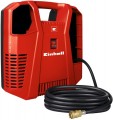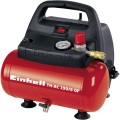Drive
The method of transferring rotation from the motor shaft to the working mechanism of the compressor.
— Straight. In
direct drive compressors, the operating mechanism shaft is aligned directly with the motor shaft — therefore, such models are also called coaxial. Their main advantage is the low cost due to the simplicity of the design, as well as the small dimensions of the compressor unit. However, this simplicity does not extend to repairs: it is likely that even with a small malfunction, you will have to disassemble most of the device. In addition, this option is characterized by a high level of noise, and the speed of rotation of the shaft is quite high, which greatly wears out the working mechanism. It is very difficult to create a high-performance compressor based on a direct drive, because design features adversely affect cooling efficiency. Therefore, such models usually belong to entry-level devices with low performance.
—
Belt. The operation of this drive is based on the use of two pulleys (one on the motor shaft, the other on the shaft of the working mechanism) connected by a drive belt. It is more bulky, somewhat more complex in design and more expensive than a straight line, but outperforms it in a number of other indicators. First of all, this is performance: separately located engine and working mechanism is much easier to cool, which allows you to create compressors of almost
...any capacity without the risk of overheating. In addition, due to the difference in the diameter of the pulleys, the speed of rotation of the shaft of the working mechanism is lower than that of the engine, which further reduces heating and has a positive effect on the resource. Belt-driven compressors are easy to repair and maintain (due to the ability to access the engine and mechanism separately), and their noise level is low.Input performance
The amount of air that the compressor is able to process per unit of time; usually stated in liters per minute. Performance, along with pressure (see below), is one of the most important parameters: it is it that primarily determines how compatible the compressor will be with one or another pneumatic tool.
It is worth choosing a model according to this indicator in such a way that it can be guaranteed to “pull out” all the tools that can be connected at the same time. Air consumption is usually directly indicated in the characteristics of each tool, and it is quite simple to calculate the total requirement. However, due to the design features, the compressor must have a certain performance margin; the specific value of this stock depends on a number of nuances.
The main point is that some companies indicate for their units the performance at the outlet (how much air is supplied to the tool), while others indicate at the inlet (how much air the compressor sucks in). Since no compressor is perfect, part of the air is inevitably lost during the compression process, so the amount of air at the outlet will always be less than at the inlet. Accordingly, if the output performance is indicated in the characteristics, a margin of 10-20% is recommended, and if the input is 35-40%.
There are also more complex techniques that allow you to more accurately derive the required performance depending on the characteristics of specific tools; they can be found in...special sources.
Rotation speed
The speed of rotation of the compressor motor shaft in normal operation. This parameter, usually, does not affect the efficiency of the unit — the main indicators are still the performance and nominal pressure (see above). At the same time, it allows you to evaluate the design features of the compressor and its durability. The fact is that a higher rotation speed allows the use of fairly simple and inexpensive working mechanisms, but it increases the wear of moving parts and reduces the motor resource. Therefore, a model with a lower number of revolutions is likely to cost more than the "high-speed" version, but it will also last longer (ceteris paribus characteristics — performance, pressure, drive type, design; see all above).
Receiver
Air tanks, or receivers (for details, see "Receiver volume") for modern compressors are usually made in a shape close to cylindrical, and can have both horizontal and vertical arrangement. Each option has its own characteristics:
— Horizontal. Such receivers require quite a lot of space on the floor (or other surface), but this moment also has a “reverse side” — the area of the upper part of the tank is also quite large, and belt-driven mechanisms can be placed on it without problems (see "Drive") . In addition, the horizontal arrangement allows the use of tanks of almost any volume, from small to very capacious, and the compressors themselves are very stable — it is almost impossible to accidentally overturn such a device. Therefore, this option is by far the most common and is found in the vast majority of models.
— Vertical. The main advantage of such receivers over horizontal ones is the relatively small amount of space required for installation. On the other hand, the vertical layout imposes serious restrictions on the maximum volume of the tank, and a small amount of space on top is usually only suitable for direct drive systems (see above). And the stability of such structures is somewhat worse. Therefore, this option has not received wide popularity, and it is worth specifically looking for a vertical compressor only if the situation does not allow the use of a horizontal model.
— Is absent. Models supplied without any receiver at a...ll.
The main advantages of tankless units are compactness, light weight and relatively low cost. However the air flow from them is relatively uneven, but in many cases this is not a drawback; in addition, various solutions can be used in the design, to some extent compensating for this drawback, and some compressors without a receiver are even positioned as devices for the same airbrushing.
Receiver volume
The receiver is a tank (cylinder) into which compressed air is pumped during operation of the compressor; it is from this cylinder (and not directly from the working mechanism) that it is fed to the connected instrument. The main meaning of such a scheme is that the receiver compensates for pressure unevenness that occurs during the operation of the main mechanism; it does not guarantee absolute constancy, however, all changes occur very smoothly. In addition, energy savings are ensured in this way: part of the time the compressor runs on the stored air from the receiver, and the engine turns on only when the pressure in the tank is significantly reduced to replenish supplies. Therefore, this piece of equipment is practically mandatory, models
without a receiver are extremely rare today.
In general, the larger the volume of the receiver, the less often it will have to be pumped up after the initial filling with compressed air. It is also believed that a volumetric receiver can partly compensate for the lack of compressor performance; however, this moment does not ensure the constant stable operation of the “gluttonous” tool and serves only as a fallback in case of a short-term increase in air consumption. On the other hand, large volumes mean the corresponding dimensions of the tank (and it is already the largest part in most compressors), and the cost of the device increases accordingly. Therefore, when choosing, it is worth observi
...ng a certain balance and choosing a receiver depending on the specifics of the work. For various types of activities there are recommendations, they can be found in special sources. Here we note that for relatively uniform work in time with a small air flow, a small receiver is usually enough, and if peak loads can occur frequently, it is better to choose a larger cylinder.
Some compressors may provide the expansion of the receiver with additional tanks.
